|
Freiwilligen Legion Flandern
Belgium is a divided country, with two different social classes. 
Flemish Legion Insignia
The battalion "Flandern" received orders transfering it to the Heidelager
training camp near Debica, Poland. At the Debica SS camp, the
legionnaires were soon join by the rest of the Flemish personnel.
The Flemish Legion was joined with the Dutch Legion for combat
training. On early September, the Flemish Battalion left for the
SS Camp at Arys in East Prussia. 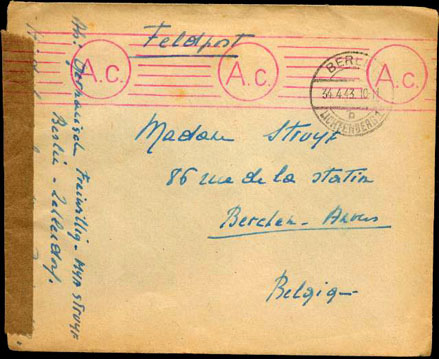
Flemish Legion Feldpost Very rare and interesting feldpost cover mailed in April 1943 by Flemish female volunteer who was by the railroad station in Berlin Zehlendorf and shows postal cancel from Berlin-Lichtenberg railroad station. Cover has been sent to family member in Berchem, a southern district of the municipality and city of Antwerp It has been censored and has sealing tape. The sender could be the Flemish artist Mya Struyf probably doing propaganda service for the Flemish Legion or Germans. | |
|
6. SS Freiwilligen Sturmbrigade Langemarck 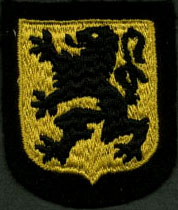
Flemish Legion Feldpost
On 20 April 1942, former members of the "4. SS Infanterie Standarte
Totenkopf" were awarded the honorary title of "Langemarck." Because
of the constant battles during the winter of 1941/1942, only 180
men out of 3000 remained! By the end of May 1943, the decimated
unit was rebuilt from German and Flemish volunteers. Members from
the Flemish Legion who were on training in Debica, (Poland) were
incorporated into the newly formed Langemarck Brigade. 
Flemish Propaganda Postcard | |
|
27. Freiwilligen Grenadier Division der SS Langemarck By
late September 1944 most of Belgium had been liberated. Many Flemish
collaborators accompanied the retreating Germans. These collaborators
now found themselves deprived of their citizenship and unemployed in
Germany. On 30 October 1944, the 6th Brigade was sent to Luneburger Heath,
Germany. The physically fit were drafted into the new designated Waffen-SS
division, the "27. Freiwilligen-Grenadier Division der SS Langemarck." 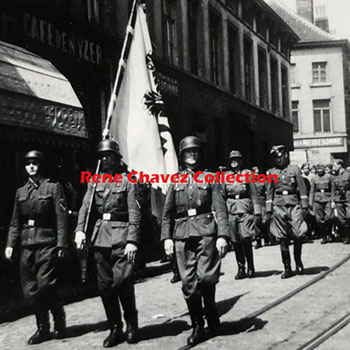
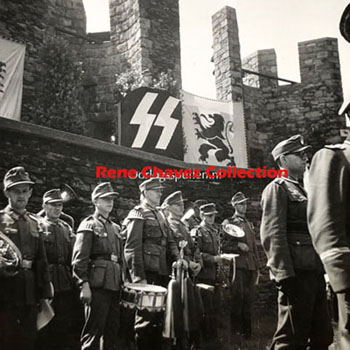
| |
|
Flemish Postal History Postal History: During late May 1941, free postal privileges for mail weighing up to 250gms, were given to Belgian nationals while serving in the German armed forces. A fee of 3 Francs was charged in Belgium for mail weighing 250 to 1000gms. A 20Rpf for mail posted by Germans nationals. | |
|
Feldpost numbers assigned to the Flemish Legion From July 1941 to April 1943, Flemish personnel serving in the Waffen-SS Legion received following Feldpost unit numbers: Reserve Staff-------------- 44853A 1st. Rifle Co. -------------- 44853B 2nd. Rifle Co.-------------- 44853C 3rd. Heavy Inf. Co.------- 44853D 4th. Heavy Mortar Co.-- 44853E 5th. Anti-tank Co.---------- 44853F On May 31, 1943, the Flemish Legion was reformed as "6th SS Volunteer Assault Brigade Langemarck." New Feldpost numbers were assigned as follows: Brigade Staff------------------- 44853 1st. Btl. (1-4 Co.)--------------------- 34695A-D 2nd. Btl. (5-8 Co.)-------------------- 17662A-D Administrative Company----- 37892 8.8cm. Anti-aircraft Battery-- 45214 2.2cm Anti-aircraft Battery-- 45840 Field Reserve Co.------------- 56414 Assault-gun Battery 56.----- 40035 Anti-tank Company------------ 21836 Transport Column-------------- 32401 | |
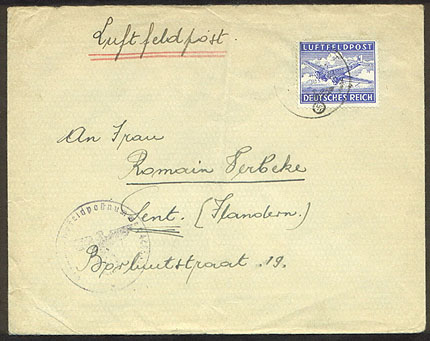
6th SS Assault Brigade Langemarck Feldpost Rare "Luftfeldpost" cover mailed by a member in the 6th SS Assault Brigade Langemarck. The feldpost cancel although not clear shows the postal cancel dated July 1943 and it was mailed to Gent, Flanders. In addition, it shows the unit seal of the SS-Brigade Staff personnel. 
The reverse shows the senders rank and FPN 44853E (4th Heavy Mortar Co.). The cover
was censored as shown by the sealing tape and red censor markings. | |
|
On October 1944, the 6th SS Brigade was reformed as "27th SS Volunteer Infantry Division." New Feldpost numbers were assigned as follows: Divisional Staff--------------------------------- 44853 Military Police Troops and Staff----------- 64116 SS Volunteer Infantry Regiment 66 Regimental Staff-------------------------------- 04206 1st. Btl. (1-4 Co.)------------------------------------- 64485A-D 2nd. Btl. (5-8 Co.)------------------------------------ 17662A-D SS Administrated Co.-------------------------- 37892 SS Volunteer Infantry Regiment 67: Regimental Staff----------------------------------- 05294 1st. Btl. (1-4 Co.)---------------------------------------- 34695A-D 2nd. Btl. (5-8 Co.)--------------------------------------- 07073A-D Regimental Staff----------------------------------- 64712 1st. Btl. (1-4 Co.)---------------------------------------- 04336A-D 2nd. Btl. (5-8 Co.)--------------------------------------- 65078A-D SS Rapid-fire Co. 27------------------------------- 05150 | |
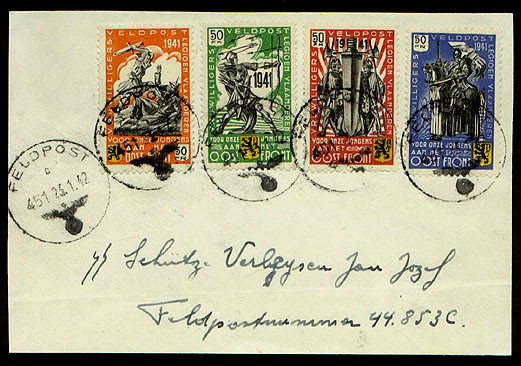
Rare Flemish Legion
feldpost cover addressed to FPN 44853C, assigned to the 2nd Rifle Co. SS Artillery Regiment 37: Regimental Staff----------------------------------- 05814 1st. Battalion (1-3 Battr.)------------------------- 07534 2nd. Battalion (4-5 Battr.)------------------------ 06939 3rd. Battalion (7-8 Battr.)------------------------ 66124 4th. Battalion (10-11 Battr.)--------------------- 07944 SS Artillery Regiment 27: Staff Service Regiment 27. --------------------- 66752 Service Regiment Unit--------------------------- 32401 SS Military Police Troop 27.------------------- 64116 SS Veterinary Co. 27.---------------------------- 06263 SS Administrated Co. 27. ----------------------- 06588 SS Engineer Battalion 27. ---------------------- 66467 SS 8.8cm. Anti-aircraft Battery --------------- 45214 SS 2.2cm Anti-aircraft Battery ---------------- 45840 SS Anti-tank Co. 27. ----------------------------- 21836 SS Signals Unit 27. ------------------------------- 44853 SS Anti-tank Unit 27.----------------------------- 21836 SS Field Reserve Battalion 27. ---------------- 65547 SS Supply Regiment 27.------------------------- 66752 SS Medical Co. & Ambulance Platoon------- 65902 SS Field Postoffice 27.---------------------------- 66997 | |
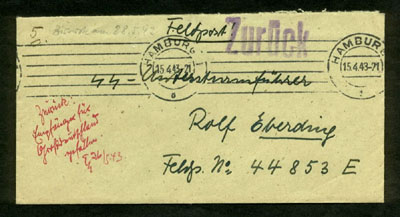
Flemish Legion Feldpost Interesting
Flemish Legion SS-Feldpost cover that was mailed to FPN 44853E (4th Heavy Mortar Co.),
however, it was returned as indicated by the purple marking.
This cover was sent to SS-Unterscharführer Rudolf Eberding who was the oldest of three
brothers who joined the Waffen-SS. Eberding was originaly a member of the
SS-Freiwilligen-Standarte "Nordwest." [ Front Page ] [ Top] [Previous Page [ Next Page] |
|